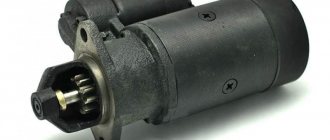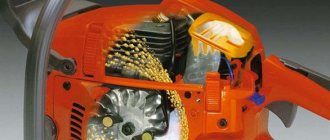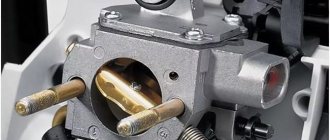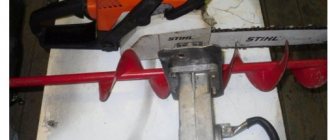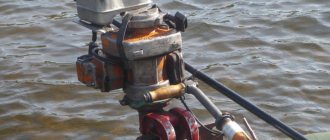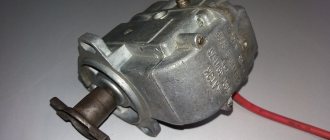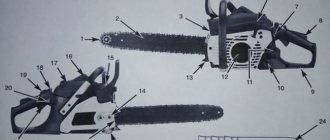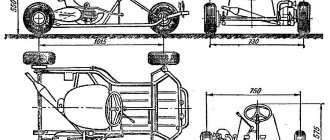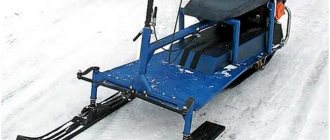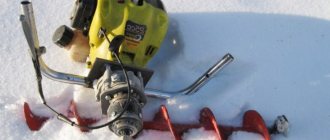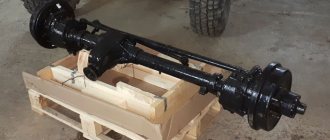What is a starter on a chainsaw
If chainsaws differ from each other in any way, it is only in technical parameters. Otherwise, they have a similar design, and especially the starters are arranged in the same way on all instruments. These parts also have a simple design, so their repair is not very difficult, and any sawyer can do it. Even if you have never had to deal with a trigger mechanism, the need to repair it will not be difficult to study its operating principle.
Chainsaw starter circuit diagram
A starter on a chainsaw consists of a number of the following main parts:
- Drum or reel. The basis of the mechanism on which the cord is wound. The drum is connected to the crankshaft of the chainsaw engine.
- Cord or rope. It is designed to drive the drum and thereby start the engine.
- Handle at the end of the cord. It performs several functions at once. The first is the convenience of performing manipulations to start the engine by pulling the cable. The second will act as a limiter, preventing the end of the rope from being completely wound around the drum.
- A frame that is equipped with a spring that helps return the drum to its original position. It is thanks to these elements that the cable returns immediately after each attempt to start the internal combustion engine.
Every owner of this tool knows how the chainsaw engine starts. However, how this process is implemented inside the trigger mechanism is not known to everyone. Knowing this principle is especially important for those who are planning to repair the starter.
When the sawyer pulls the handle, trying to start the engine, the following actions occur inside the mechanism:
- the drum engages with the flywheel (the latter is connected to the engine crankshaft). There are teeth (hooks) on the drum, and pawls on the flywheel, which, connecting to each other, ensure the movement of the crankshaft when the starter handle is pulled;
- when the cable protrudes from the mechanism to its full length, it returns back. It is wound onto the drum by a return spring;
- When the engine starts, the movable splines (aka pawls) on the flywheel are separated from the protrusions in the drum.
The chainsaw engine starts on average after 3-5 pulls of the cable (in practice, much more). The initial manipulation must be done several times without turning on the ignition in order to pump into the cylinder a sufficient amount of fuel assemblies necessary for a successful start. After this, the ignition is turned on, and the engine is expected to start. For various reasons, the engine may start the first time or the tenth time. However, if the starter is faulty, it will be impossible to start the chainsaw.
Starters come in different designs. Below in the video you can see their varieties for Chinese chainsaws.
Design and principle of operation
The operation of the starter consists of the following: on the body of the chainsaw there is a handle through which a special cable passes, pulling and engaging the ratchet drum when pulled sharply. With all this, the movement is transmitted to a drum with splines on the shaft.
At this time, the crankshaft makes several full revolutions, as a result of which the working mixture is compressed between the cylinder head and the piston. If you let go of the handle, the contact between the splines and the ratchet will be lost, resulting in the shaft simply stopping!
The larger the volume of the chainsaw motor, the more fuel-air mixture will be needed for the upcoming ignition. Based on this, to start high-power saws, you usually need more pulls on the starting cable. For greater ease of operation and to speed up the return of the drum, manufacturers began to use involuntary return springs made of elastic steel.
Simplification of starting a chainsaw is obtained due to the following reasons:
- The presence in the design of some chainsaw models (for example, in the Maxcut, Partner S line models, etc.) of a special pump that guarantees timely pumping of the fuel mixture.
- Installation of an additional spring, which ensures easier unwinding of the crankshaft when the cable is displaced.
- Due to the preparatory enrichment of the consistency through a suitable damper in the carburetor body.
- Placement of an automatic decompression valve, which will reduce the operating pressure inside the cylinder.
All types of chainsaw starter breakdowns and techniques for properly eliminating defects
The starter, like any other tool part, is subject to wear. Sooner or later it will become unusable and will need to be either replaced or repaired. Of course, repair is a more rational way to solve the problem, but the possibility of its implementation depends on the cause and type of malfunction.
The starter life depends on various factors:
- quality of the component parts of the mechanism;
- tool motor start frequency;
- correct implementation of the process (you cannot sharply pull the handle of the mechanism, and it is also strictly forbidden to hold it extended when the engine is running).
You can determine that the chainsaw starter is faulty by characteristic signs. When you pull the handle, you feel the ease of the process. Which means the drum is not engaging the flywheel. However, the symptoms depend on the type of malfunction, so we will analyze them in detail.
Typical faults
If the operating rules are followed and used carefully, a chainsaw can serve the owner for many years. However, minor malfunctions and problems still arise. Among the most common breakdowns are problems in the ignition system and starter problems.
- broken or burst pulley;
- break of the starting cable;
- broken starter spring.
The most common tool failures include the following:
- problems in the ignition system;
- stopping the chainsaw while cutting;
- loss of power during operation;
- wear of some structural elements of the chainsaw (brake band, drive sprockets, anti-vibration parts);
- problems in the fuel supply system;
- starter related problems.
In addition, it is necessary to carry out a visual inspection of the chainsaw before starting work and take preventive measures. These include lubrication of the chain, control of the amount of fuel mixture, as well as the presence of the required amount of oil.
The spark plug is unscrewed to check its condition.
Each of the faults is eliminated using its own technology. For example, repairing the fuel system of a chainsaw should begin with inspecting the corresponding filter. After this, check the correct adjustment of the carburetor, which is carried out using screws. The gaps must be set in strict accordance with the manufacturer's instructions, which must be included with the chainsaw.
The gaps must be set in strict accordance with the manufacturer's instructions, which must be included with the chainsaw. Repair of the ignition system includes inspection of spark plugs. If heavy carbon deposits, changes in clearance or other visible damage are detected, this element must be replaced.
Repairing the starter cord if it breaks: replacement instructions
Chainsaws do not use metal cables, which would last longer than textile ones, but their use would complicate the immediate process of starting the engine. Although textile rope is highly durable, its structure is damaged over time (especially when exposed to negative factors, such as oil). During operation, friction occurs, and at one point it can simply come off. If this happens, then it will not be possible to make a knot at the break site. In this case, you will need to replace the rope.
It can be purchased in specialized stores or selected with a similar diameter. The replacement process is not complicated, but it involves dismantling the starter. After this, you need to remove the drum and cut off the rest of the broken cord from it. Next, the required length of the cord is measured (usually no more than 1 meter), and one edge must be tied into a knot. Pass the free end into the hole in the drum, then into the hole in the starter housing, and only then connect it to the handle.
If it does not work out
When all actions are performed in accordance with the established order, and the chainsaw does not start working, then malfunctions occur in its mechanism. Common and easy to fix problems such as lack of spark, clogged filter passing through the air are common causes of this phenomenon. To start chainsawing, you will need to find the cause and take the necessary steps to eliminate it.
You only need to do the right things
Lists actions that must be performed in a strict order. Only when moving from one activity to another can you determine the exact cause of the problem and quickly fix it without damaging other parts. Algorithm of actions performed in case of failures in creating a chainsaw:
- Firstly, this is enough for the device to remain. This is especially true for saws that have been in use recently. It is enough to wait no more than 10 minutes, since during this time the mechanism will cool down, and in the absence of other breaks it will easily start. Sometimes it happens that during the institution a candle is poured onto the device. If this unpleasant behavior occurs, then it is enough to wait a very short pause and repeat all the steps for winding the motor again.
- The housing cover is unscrewed from the device to remove the air filter. The process of planting the device is carried out in his absence. Sometimes the reason for lack of ignition is a dirty filter. If ignition occurs without it, then this is precisely the reason. To eliminate these problems, simply wash the filter under running water with warm water and soap, and then dry it. You can also replace the old element with a new one.
- The spark plug has been removed. There is a spark test. If it does not appear, you need to replace the old spark plug with a new one. Usually this helps and a spark appears, but in some cases, and when the mixture is replaced, there is no spark.
This means that the ignition unit is damaged and the chainsaw needs professional repair. Sometimes the faulty ignition unit is also in the presence of a spark, so this criterion cannot be used to eliminate the possibility of failure.
When the spark appears when you are unable to get the device to work, you must continue with the steps below.
There are times when a spark appears, but the candle itself is moistened. This is possible if he receives gasoline. To get rid of it, just turn the device so that the cylinder is the output one. Then all excess liquid will flow out. Then you need to check the combustion chamber, which is necessary to pull the starter more than 10 times. You can try to replace a damaged spark plug and then check the efficiency of its operation. If it becomes faulty, you can replace the item with a new one. After these steps, you should try to activate the device again.
Sometimes the candle remains dry. In this case, you need to draw a gas mixture into the syringe and inject it into the cylinder. After this, you should immediately try to start the device. If the reason for a long lack of response to attempts to start is debris falling into the carburetor, then removing it should not interfere with the fuel entering the combustion chamber. The mechanism for successful garbage collection is determined by the flow of liquid when pouring the gas mixture, so you need to force fill the fuel and then almost immediately try to start the device. The muffler is removed. To do this, it is unscrewed and carefully removed so as not to deform the gasket that limits it from the engine. It is necessary to try to create a mechanism without using an air filter and a muffler, which will help avoid breaks in these structural elements.
If there is any damage to the cylinder walls, it can be concluded that it will need to be professionally repaired or replaced with a new one. Typically, such failures result in insufficient oil concentration in the fuel.
Starter repair if the return spring is damaged
This part is needed to return the drum to its original position. And although the part has a long service life, its failure cannot be ruled out. It is important to note that the starter design can have either one spring (the most popular option) or two. The possibility of repair depends on the location where the fracture occurred. If it is damaged at the point of connection to the drum, then it will not be difficult to make a new loop and continue operating the mechanism. To do this, the place of the future bend should be heated to a high temperature (about 600 degrees - you can tell by the color when it turns red), after which, when it gradually cools, you need to bend it. You need to bend it using two pliers.
If the spring bursts in another place, then it needs to be replaced with a similar one. It is important to choose a part for your tool model or select it by size and number of turns. How to dismantle the chainsaw starter and replace the spring can be seen in the video below.
Interesting! If there is no lubricant on the spring, it is recommended to lubricate it. If the spring shows signs of corrosion, then it is better to replace it immediately.
Fuel system
Malfunctions of the fuel system are also quite often the main reason that prevents a chainsaw from working as efficiently as possible. First of all, you need to check the quality of the fuel mixture.
Gasoline leaks from a chainsaw
If gasoline drops periodically appear on the body of the chainsaw, then it is necessary to check the tightness of the fuel tank. Over time, it may dry out. Or the gasket has become “stiff” and it can no longer perform its direct function.
If full-fledged gasoline streams appear, then there is a high probability that you will have to change the burst hose connecting the carburetor and the fuel tank.
Gasoline does not enter the chainsaw cylinder
There are several reasons why the fuel mixture stopped flowing into the cylinder:
- The air filter is clogged.
- The carburetor settings have been lost.
- The carburetor membrane is no longer intact.
- The channels through which gasoline is transported are clogged.
How to repair a starter if the splines on the drum are deformed and the pawls on the flywheel are damaged
If you pull the handle very sharply, the plastic teeth on the drum may fail (simply break off). Naturally, such a part is not subject to further use. It only needs to be replaced, with which no one has any problems.
Sometimes the pawls on the flywheel also become damaged. Their design may vary. They can be presented both in the form of metal elements and plastic. Plastic devices may become damaged and will need to be replaced. The replacement method depends on the design. The easiest option is to unscrew the pawl and install a new one in its place. More complex designs require the flywheel to be removed.
The process of removing the flywheel is quite labor-intensive, so you will need a special tool, as well as time and a little effort. How to remove the chainsaw flywheel to replace the pawls is shown in the video below.
Features of repair may vary depending on the design of the instrument. However, the mechanisms have an identical design, so even a beginner can restore their serviceability without the need to hand over the tool to qualified specialists.
In conclusion, it is important to note that the starter is no less important part of the tool than other parts. After all, without it it is simply impossible to start the engine. To ensure that the unit does not fail at the most crucial moment, it is necessary to inspect it at the first signs of wear and tear, and eliminate faulty parts or add lubricant for better functioning. This will extend the life of the mechanism and prevent it from breaking down when the sawyer works in the field.
Why is primary adjustment needed?
Initial running-in of the chainsaw: working with thin material
Most modern chainsaws are sold adjusted. However, it doesn’t hurt to check the quality of the factory settings - in the end, it’s you who will have to work with the tool.
When starting up for the first time, the chainsaw should operate in a gentle mode. Therefore, for several hours after start, it is recommended not to overload the engine and cut only small branches and trunks up to 10 cm thick.
Simple rules will help you insure against malfunctions of the chainsaw carburetor:
- Always mix gasoline and oil according to the manufacturer's instructions.
- Do not prepare the fuel mixture in advance - the properties of gasoline and oil in a mixed state are lost over time. The exception is fuel for intensively used tools, however, even here the norm should not exceed approximately a week.
- Use oil designed for your chainsaw engine. A fuel mixture with a non-standard composition will seriously and permanently disable it.
- When preparing the fuel mixture, take into account the influence of climatic conditions on its components.
The chainsaw must start correctly, ensure a stable rotation speed of the sprocket and a smooth increase/decrease in power. There should be no extraneous knocks, pops or noises when the engine is running.
Professional hand chainsaw at work
The main thing during the initial running-in of the tool is to ensure that the fuel consumption corresponds to the power used, i.e. in practice, the saw should not go out, “sneeze”, smoke or run jerkily.
Malfunction of unspecified category
In some cases, owners of chainsaws have to solve more complex problems to fully restore the functionality of their cutting tool.
The chainsaw does not develop full power
In addition to the problem discussed above with a lack of gasoline or air entering the cylinder, the cause of low power may be a clogged muffler.
Carburetor depressurization and nozzle blockage
Over time, the screws holding the carburetor cover in place can become loose or the gaskets can become unusable. A clogged filter or improper replacement can lead to clogged injectors. All this also negatively affects the operation of the chainsaw and shortens its service life.
Chainsaw won't idle
It often happens that after long-term transportation and constant use, a chainsaw refuses to idle smoothly. As a rule, this problem is eliminated by adjusting the carburetor.
You can learn how to properly debug the carburetor from this video:
If the carburetor is tuned like a clock, then you need to check:
- Fuel system. It makes more sense to start with the fuel pump.
- Muffler. There is a high probability that due to the abundance of accumulated soot, the engine cannot function normally.
Chainsaw loses power under load
If during operation the power of the saw disappears somewhere, then the problem should be looked for in the following places:
- In the muffler. It, as you already understood, tends to get clogged.
- In a clogged fuel filter.
- A poorly functioning fuel pump.
